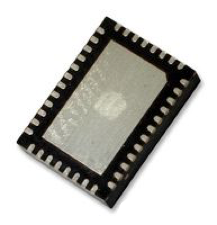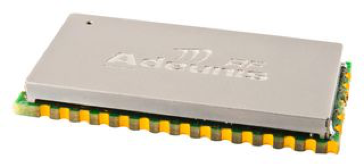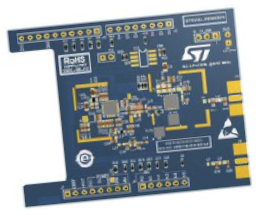Wireless solutions #5
SigFox - Fulfilling an IoT communications need
We’re all used to local area networks such as Wi-Fi, ZigBee and Bluetooth that typically span just a few meters. They connect gateways with IoT devices ranging in complexity from PCs and printers, to doorbells and thermostats. However, IoT technology is just as much about large-scale schemes spread over a wide geographical area, such as monitoring of air pollution or water level, controlling traffic flow and car parking, agricultural and other applications. Although widely diverse, these applications create a common set of demands on the sensors and communications networks they use:
- Since these applications typically deploy sensors in large numbers and widely-dispersed locations, they must operate with minimal power consumption. This may allow energy harvesting, or at least maximal intervals between battery changes, minimising costs associated with accessing and changing large numbers of batteries. Accordingly, the wireless communication network must also be low-power to support this objective.
- Such sensors typically do not generate high volumes of data, and may even be inactive for extended intervals. Meanwhile, the associated costs, like the power budget, must be minimised. These scenarios call for a network protocol that prioritises power and cost reduction over unnecessarily high data rates.
- Low cost should mean zero or low subscription charges as well as simple hardware with low pricing.
- Long distance transmissions should be possible, with robust resistance to noise.
- Network capacity must be high to accommodate the substantial number of edge devices that may be found in a large-scale project.
- Security should be included.
So, what are the main long-range wireless networks available, and how are they equipped to meet these challenges?
The most widely-established choices come down to licensed cellular wireless protocols in their various flavours, and low-power wide area networks (LPWAN) such as LoRaWan and SigFox – that don’t need SIM cards for connectivity.
Cellular networks benefit from having a well-established, stable infrastructure in most locations around the world . However, these networks were not originally developed with IoT devices in mind, and are geared towards transmitting large volumes of data with associated penalties in terms of power and financial budgets. Even LTE-M (or LTE-MTC) – developed by the Third Generation Partnership Project (3GPP) for machine communications – is expensive to implement on end devices due to high installation, maintenance and running costs. It does, however, have a low-power consumption approach.
More information on cellular networks and LPWANs is given in our articles Trends in Cellular IoT Part 1, Trends in Cellular IoT Part 2, and Trends in Cellular IoT Part 3. Another article, The LoRaWAN as an IoT network solution, looks more closely at the LoRaWAN environment. This is complemented by the current article, which focuses on Sigfox.
Overview of Sigfox architecture and features

Fig.1 shows the key Sigfox network components.
Sigfox is rolling out the first global IoT network to listen to billions of objects broadcasting data, without the need to establish and maintain network connections. This approach features no signaling overhead, a compact and optimized protocol, and no need to attach objects to the network. Sigfox offers a software-based communications solution, where all the network and computing complexity is managed in the Cloud, rather than on the devices. These features combine to drastically reduce energy consumption and costs associated with connected devices.
Sigfox is a global network built using simple star topology, but objects are not tied to specific base stations. Billions of objects transmit their messages to be picked up by base stations within range, while every base station deployed around the world by network operators is directly connected to the single Sigfox cloud. The base stations detect, demodulate and report the messages to the one and only Sigfox cloud. The cloud then pushes the messages to the customer servers and IT platforms.
Sigfox design features – a closer look
Ultra Narrow Band radio modulation
UNB offers large channel capacity, long transmission distances, and resilience to noise.
- Sigfox uses Ultra Narrow Band (UNB) radio technology at 868 MHz (regulated by ETSI 300-220) in Europe and the Middle East, and 902 MHz (regulated by FCC part 15) in North America.
- These are publicly available bands.
- It has a 192 KHz bandwidth.
- UNB generates a relatively narrow radio signal. Accordingly, a greater number of signals can be carried simultaneously.
- Each message is 100 Hz wide and transferred at 100 or 600 bits per second, depending on region.
- Modulation and protocol choices of Sigfox are not optimised for high speed, but they are highly efficient when it comes to the budget link. Sigfox’s high budget link enables a long communication distance.
- UNB also uses smaller radio frames; this increases data capacity and reduces power compared with a conventional protocol having a larger overhead.
- Long distances with high resilience to noise can be achieved.
- Uses D-BPSK (Binary phase shift keying) modulation: uses only 1 Hz to transmit at 1 bps, so one signal takes a minimal slice of communication band.
- D-BPSK is used for three reasons:
- Easy to implement
- Low bit rate enables use of low cost components
- As Sigfox signal power is concentrated on a narrow bandwidth, base stations can be very sensitive, and can demodulate signals close to the noise floor; improves resilience to interference
- Base station sensitivity can be -142 dBm at 100 bps, and -134 dBm at 600 bps

Fig.1: Sigfox UNB frequency Spectrum – Image via Sigfox
Lightweight protocol
Sigfox is designed to send small messages with minimal overhead; this means less power consumption and longer battery life. Conventional systems’ protocol is optimised to carry a large volume of data, but is usually highly inefficient. A Sigfox frame carries 12 bytes of data, with a maximum including overhead of 26 bytes. By comparison, an IP stack has a 40-byte header, even with 12 bytes of data to transport.
Conventional systems use overhead traffic to create and manage the network channel without any optimisation for sparse data. This lightweight protocol has two important benefits:
- Each data and overhead byte consumes energy, so using these efficient frames optimises end devices’ battery life
- Less overhead means more capacity for user data
Small payload
An uplink message has up to 12 bytes of payload and takes an average 2 s? over the air to reach the base stations which monitor the spectrum looking for UNB signals to demodulate. For a 12-byte data payload, a Sigfox frame will use 26 bytes in total. 12 bytes is for example:
- 2 GPS coordinates, down to 3m precision
- 6 Lab thermometer reports within -100°/+200° range with a 0.004° precision
- 12 reports of speed radar up to 255 km/h
- 96 Switch reports like: set to day/night, hot/cold, on/off
- Zero-byte messages are also used, to indicate that a device is alive and online
12 bytes is a maximum, not a requirement; sending only the required data packet size saves energy and battery life. A device can transmit up to 140 messages per day. The payload allowance in downlink messages is 8 bytes, with 4 messages a day allowed. Uses for downlink messages include:
- Request additional data related to a device event
- Adjustments; sensor scale, message frequency, etc
- Request a firmware upgrade – this would be implemented using a higher throughput solution such as a GSM modem at a suitable time
Other factors for quality of service, capacity and energy efficiency
Random access eliminates the need to spend overhead and waste energy in synchronising devices with the network. The device transmits a message on a random frequency, and then sends two replicas on other frequencies at different times; a so-called ‘time and frequency diversity’ mode.

Fig.2: Uplink transmission and frequency hopping – Image via Sigfox
Co-operative reception: Unlike cellular protocols, devices are not attached to specific base stations. The emitted message is received by any base stations – on average, three - that are nearby. This is called ‘spatial diversity’.
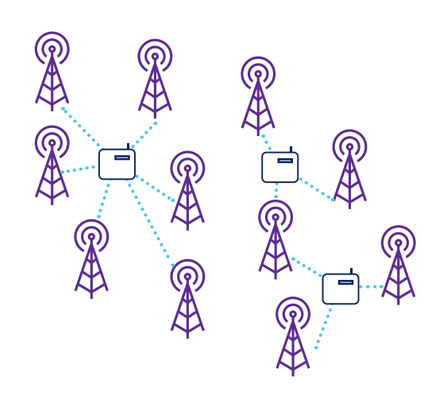
Message reception by multiple Sigfox base stations – Image via Sigfox
Low idling current: Devices spend over 99% of their time in an idle state, and idling current is very low, often just a few nanoamperes.
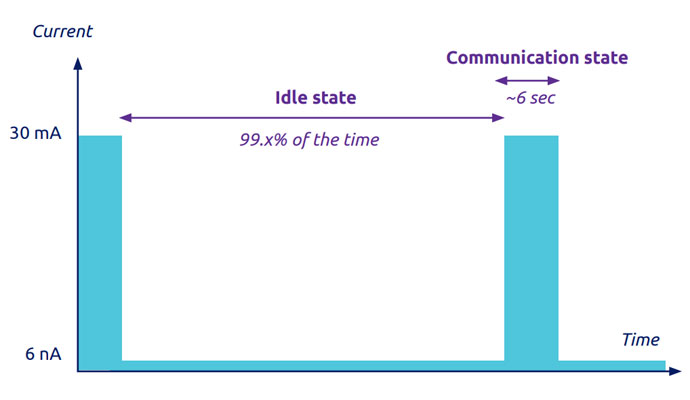
Fig.4: Low idle current means increased battery life – Image via Sigfox
The user interface and role of the Sigfox cloud
The Sigfox Cloud supports all Sigfox services. To retrieve the messages, but also to manage all the objects and user parts, Sigfox customers and partners interact with the Sigfox Cloud itself. Data access, billing, user and fleet management, service maps and other functions on the Sigfox cloud are accessible through three interfaces.
- Web portal, available through simple browser, for end-users to access all the cloud functions.
- API allows automated access to all portal-available service delivery functions using scripts.
- API access is in pull mode
- API allows integration of Sigfox functions into third-party platforms
- Example; to perform operations such as device registration within an external platform
- Callbacks: automatically receive new events, such as messages in push mode
- This removes the costly overhead (for both Sigfox cloud and customer servers) of continuously polling for messages
Access to Sigfox cloud services and tool suite depends on the user’s profile.
- An administrator can manage users and the device fleet, see service maps and check contracts
- A distributor can create contracts
- An operator can access the Radio Planning Tool and network monitoring suite
- A user may be restricted to message viewing only
Coverage and range
Sigfox can cover distances of 30 to 50 km in rural environments, reducing to 3 to 10 km in urban areas.
Sigfox’s long range is due to the low data rate, the devices’ output power and the base stations’ sensitivity. Use of a sub GHz band also allows for good indoor coverage compared with 2.4 GHz networks.
Sigfox has coverage in nearly 40 countries, either through its own, or more often through partner networks. This is detailed on its website page https://www.sigfox.com/en/coverage.
After adding WND-UK to its existing operator Arqiva, Sigfox is aiming for 95% coverage of the UK’s population by 2019. WND-UK and Arqiva networks are interoperable.
Although an apparently ambitious target, Sigfox’s low power and low bandwidth attributes will make meeting this target easier than with high power, high bandwidth services such as 4G.
“The base stations are simpler to deploy and integrate with the rest of the existing low-power network with no difficult configuration, which is very different to installing a traditional mobile cell,” according to Ian Hughes, an IoT analyst at IT advisory company 451 Research.
When using devices outdoors or near an opening, then the coverage promised is nationwide, and the coverage predictions made by SIGFOX are applicable. When using the Sigfox objects underground, in a basement, in a safe box, or other difficult conditions, a professional assessment is needed. This comprises a specific study with both theoretical simulation and field measurement. Depending on the case, the agreement needed, and the potential market itself, base stations densification might be appropriate.
Security
Sigfox implements security measures at both ecosystem and device level.
The ecosystem implements security-by-default:
- Authentication + integrity + anti-replay on messages propagated on the network
- Cryptography based on Advanced Encryption Standard (AES) with no key OTA transmission
- Payload encryption as an option to ensure the confidentiality of the data
Isolation of each part of the network and assess the risks so that in case of a hack only a minor segment of the network is impacted
For devices, Sigfox has defined three levels of security. The application provider can choose the level most suited to their project and its sensitivity.
- Medium level – the security credentials are stored in the device
- High level – the security credentials are stored in a software-based protected area
- Very high level - the security credentials are stored in a secure environment
The secure element also helps to encrypt the data that is transferred over the network. Only the device and the end-customer know the secret key. The algorithm does not impact the size of the payload. While the message is encrypted, the payload is still 12 bytes long.
Estimated Sigfox connections by 2024 (millions)
- Building automation - 433
- Smart metering – 341
- Building security – 262
- Household information devices – 250
- White goods – 228
- Agriculture – 117
Comparison between Sigfox and Lora
Business model
Sigfox owns all the technology, from the backend data and cloud server to the endpoint software.
Any silicon manufacturer can access the endpoint technology for free, subject to certain conditions. STMicroelectronics, Atmel, and Texas Instruments make Sigfox radios.
Sigfox’s aim is to make the application really inexpensive.
SigFox makes its money by making network operators pay royalties on reselling its technology stack to customers. In other words, SigFox gives away the hardware enablers but sells the software/network as a service.
The LoRa Alliance claims to be more open than Sigfox. Their network management specification is relatively open, with downloadable specifications. The open standard also has potential to be flexible, although the ‘development by committee’ approach can be slow.
As part of the openness, the LoRa Alliance wants not only network operators, but also private companies and startups, to deploy LoRa networks. This even includes crowdsourced networks such as The Things Network. This is possible because LoRaWAN is not a company, but a standard maintained by a group of companies united under the non-profit ‘LoRa Alliance’. The success of this strategy will depend on a well-formulated policy to permit roaming from public network to public network, and private network to private network.
Any hardware or gateway manufacturer can build a LoRa-compliant module or gateway. However, Semtech is the only available LoRa radio manufacturer.
In summary, Sigfox offers appreciably cheaper hardware – because they seek profit mainly from network subscriptions and aim to become a global IoT operator – while LoRa offers a more open standard, even encouraging users to build their own networks. The LoRa Alliance’s goal is to establish standards and sell chips. Sigfox has a more established global presence, but the system technology pertains entirely to a single vendor.
How to choose between Sigfox and LoRa
Sigfox is better for applications such as sensors, meters and alarms that only send out small and infrequent bursts of data, and don’t need control inputs. LoRa is more useful in applications such as electric grid control when command and control functionality, with full bidirectional communications, is needed. Table 1 below provides a more detailed comparison between the two standards.

Table 1: Sigfox/LoRa comparison
Development and design products
Farnell element14 offers a number of Sigfox development and design products; some examples are shown below.
ON Semiconductor AX-SFUS Ultra-low power Sigfox compliant transceiver IC for Uplink and Downlink
AX-SFEU and AX-SFEU-AI are ultra-low power single chip solutions for a node on the Sigfox network with both up- and downlink capability. The plug ‘n’ play AX-SFEU chip contains all of the firmware necessary to transmit and receive data from the Sigfox network in Europe. It connects to the customer product using a logic level RS232 UART. AT commands are used to send frames and configure radio parameters.
AX-SFUS
Sigfox transceiver IC as above, but for US region
Other countries are also supported
Adeunis Si868-25mW module
This Sigfox-compatible RF module is suitable for long ranges of up to 15 km, with very low power consumption. Target applications include IoT, sensor networks, environment, intelligent buildings, metering, security and M2M.
STEVAL-FKI915V1 - Development Kit, Sub-1GHz Transceiver, Based on S2-LP, Ultra Low Power Consumption
The STEVAL-FKI915V1 from STMicroelectronics is an ultra-low-power, low data rate Sub-1GHz transceiver development platform based on S2-LP with external FEM. It is suitable for Sigfox applications.
ARF8047PA - SigFox Sensor Transceiver
ADEUNIS RF’s Sigfox sensors are ready-to-use radio transmitters enabling any type of 0-10 V, 4-20 mA or On-Off sensor to be transformed into a wireless sensor. These products fulfil the needs of users who wish to remotely supervise all types of data (temperature, pressure, level, humidity, CO2, speed, luminosity, opening, etc.).
Conclusion
This article has shown how designers of wide-geography IoT systems have a choice of technologies for their long-distance wireless network implementation. This choice mainly – but certainly not entirely – comprises the various licensed cellular wireless protocols, and the low power wide area networks (LPWANs) such as LoRaWan and Sigfox.
The article’s comparison of these protocols has shown that no one approach is best for all applications. Cellular networks, for example, are good with devices that transmit and possibly receive high volumes of data, but cellular solutions become too costly, large and power-hungry for networks involving large arrays of far-flung, simple sensors.
The differences between LoRaWan and Sigfox are a little more subtle, so a more careful comparison of each protocol’s fit to the project requirement is called for. The ‘How to choose between LoRa and Sigfox’ section provides a starting-point, while the rest of the article provides more in-depth information about Sigfox’s structure. This can be used together with another article on our website, ‘The LoRaWAN as an IoT Network Solution’ for a detailed comparison of the two protocols.
References
https://www.sigidwiki.com/wiki/SIGFOX
https://www.sigfox.com/en/sigfox-iot-technology-overview - Ultra Narrow Band radio modulation, 3:09
http://www.rfwireless-world.com/Terminology/SIGFOX-specification-table.html
https://internetofbusiness.com/sigfox-wnd-uk-iot-network-coverage
https://www.disk91.com/wp-content/uploads/2017/05/4967675830228422064.pdf
/lorawan-as-an-iot-network-solution
Wireless solutions #5 – SigFox. Fulfilling an IoT communications need. Date published: 15th February 2018 by Farnell element14
